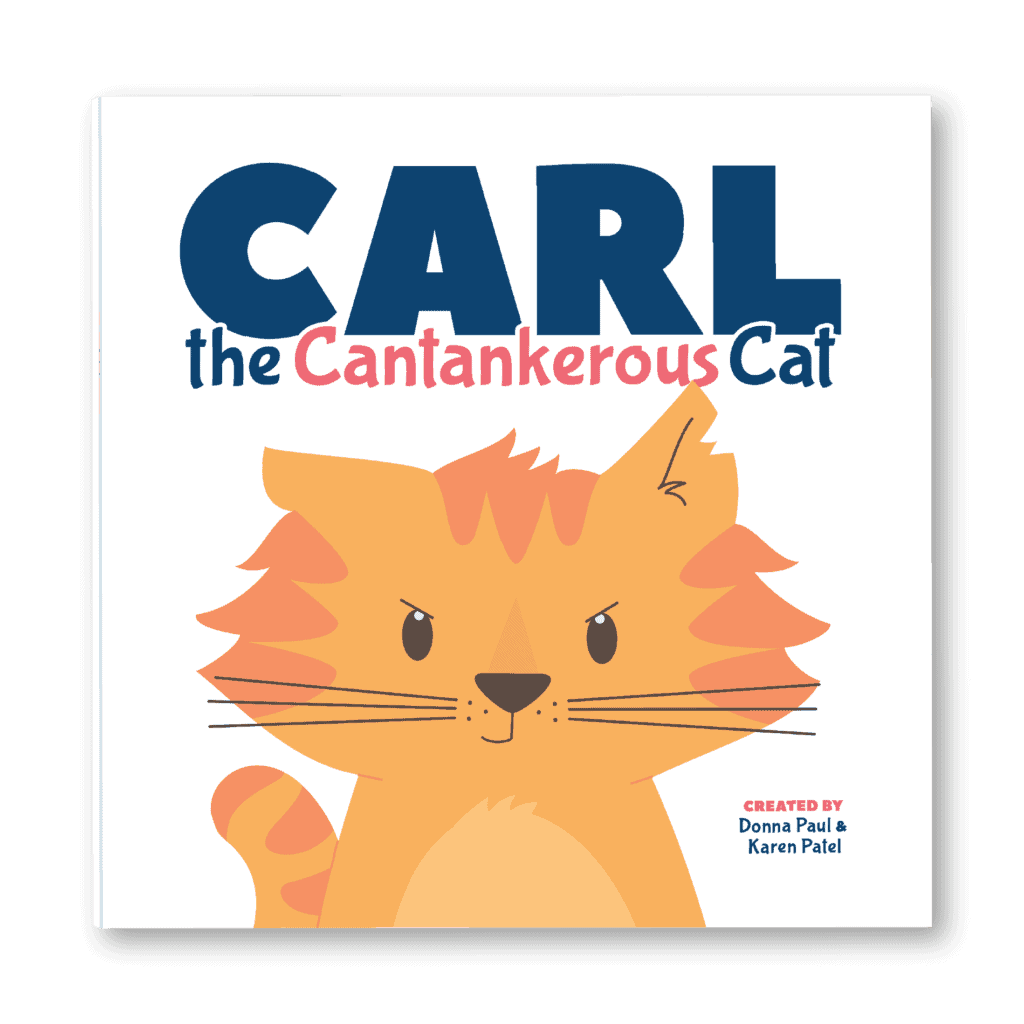Beat Summer Brain Drain In a Fun Way
Summer brain drain can wipe out up to two months of kids’ math and reading skills.
As a Montessori elementary teacher and stepmom, I know that when summer temperatures rise, we need fun, engaging ways to keep young brains from melting!
In this article, you’ll find creative and low-stress ways to keep elementary-aged kids learning all summer long. And the best part? Middle and high schoolers can join in, too.
💡☀️💡☀️💡
Our Top 5 Tools for Beating the Summer Brain Drain
Reading Materials for Kids
Board Games and Card Games
Outschool Classes
Daily Activity Planner
Rebus Puzzles
Summer Brain Drain by the Numbers
The term summer brain drain refers to the learning loss that occurs when students take an extended break from structured academic activities, typically over summer vacation. This phenomenon contributes significantly to the achievement gap, especially among students who lack access to enrichment opportunities during the break.
Here are some key statistics highlighting the impact of summer brain drain:
➡️ Students lose an average of two months of academic skills over the summer.
➡️ In math, the loss can be even greater! Up to 2.6 months of progress may disappear.
➡️ Reading skills also decline, with many students losing around two months of reading development.
➡️ Math scores tend to drop more sharply than reading scores during the summer months.
➡️ Older students experience greater learning loss, with the impact becoming more pronounced in higher grade levels.
When school resumes in the fall, the first six weeks are often spent re-teaching material from the previous year to combat summer learning loss.

To combat the effects of summer brain drain, many schools and communities have introduced summer learning programs and enrichment opportunities to keep kids engaged and growing. But you don’t need a formal program to make a big impact, with the right mix of creativity and fun, learning can happen anywhere.
Beat the Summer Brain Drain with Playful Learning
While summer break offers a much-needed pause from the classroom, it can also lead to real setbacks in academic progress, especially when kids unplug from everyday learning routines. In fact, seasonal learning loss is a major contributor to the achievement gap by high school.
The solution? Make learning part of the fun.
With playful, hands-on activities that spark curiosity, kids can stay mentally active all summer long, without it ever feeling like homework. It’s all about weaving learning into the moments they already love.
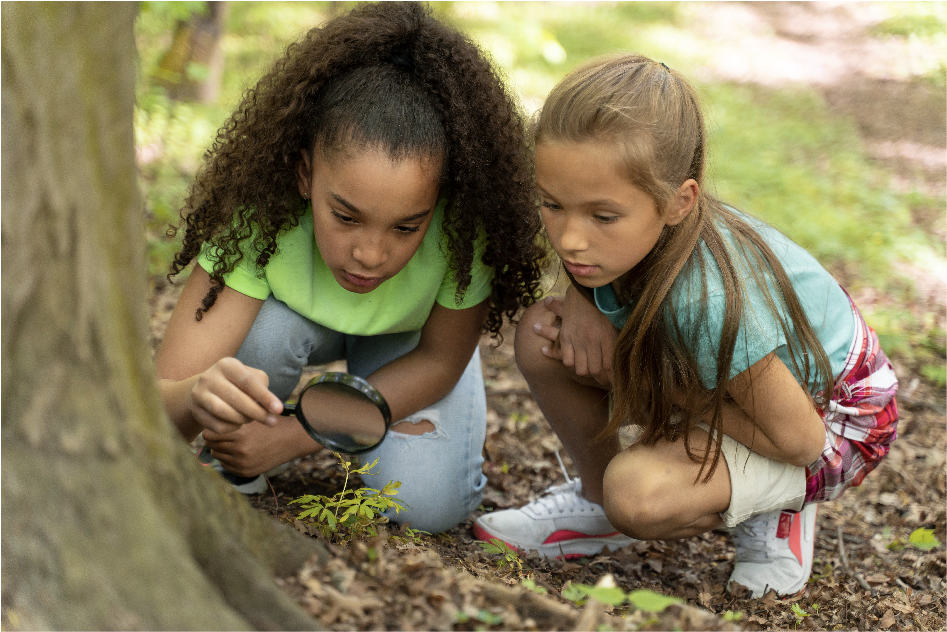
9 Ways to Avoid the Summer Brain Drain
Thankfully, with a little creativity and a summer schedule for kids, we can empower elementary students to thrive during the summer months and prevent the dreaded summer learning loss.
If you’re looking for simple, enjoyable ways to keep your child’s skills sharp this summer (without the usual “school” vibe), these ideas are for you!
1. Encourage All Sorts of Reading
Get kids to read over the summer? Sounds like a daunting task, I know. But fear not, you can make it fun and engaging!
Make reading a desirable activity by setting up a family book club or by offering fun book report activities to do after reading. Also think about taking turns reading aloud with your child because not only is it a great way to bond, but it also improves their reading and listening skills.

For reluctant readers, consider adding audiobooks or an e-reader to your routine. The benefits of audiobooks, like improved comprehension and increased engagement, are worth exploring. You can also visit a library or bookstore and let your child choose books that spark their interest.
💡 Teacher Tip: Level up reading with activity pages!
Make reading even more engaging by choosing books that come with activity pages, perfect for extending the learning beyond the story. You can also personalize the experience with an A to Z scavenger hunt template, which pairs well with any book and helps build vocabulary while sparking great conversations.
Get them reading anything and everything to avoid the summer brain drain!
As a teacher with a lot of experience in elementary classrooms, I can confidently tell you that it doesn’t really matter if it’s a fact book about horses, a graphic novel with silly characters, a joke book, a cat facts coloring book, a how-to book to learn a craft or even a book to teach them a skill they’re interested in.
What matters most is helping kids find something they enjoy reading, once they’re hooked, they’ll keep going. It’s not about what they read, but about discovering the joy of reading in everyday life.

Kid-Approved Reading Materials for Summer
🧑🏼🍳 Best reading material for food lovers:
The Help Yourself Cookbook for Kids: 60 Easy Plant-Based Recipes Kids Can Make to Stay Healthy and Save the Earth.
This cookbook empowers children to create delicious plant-based meals while developing their cooking skills. It promote healthy eating habits and instills environmental consciousness, making it perfect for kids who want to nourish their bodies and make a positive impact on the planet.
😸 Best reading material for enhancing their vocabulary:
Carl the Cantankerous Cat
This is the ultimate picture book for cat lovers! With its delightful illustrations and a heartwarming storyline, this book captures the essence of feline charm and mischief. Follow Carl’s adventures as he navigates the world with his unique personality, providing endless entertainment for cat enthusiasts of all ages.
🦡 Best reading material for animal lovers:
The Illustrated Encyclopaedia of Ugly Animals
With its captivating illustrations and fascinating facts, this book showcases a unique collection of extraordinary creatures that are often overlooked. It celebrates the diversity of the animal kingdom, shedding light on the unconventional beauty found in the natural world. This encyclopedia is an invaluable resource that fosters a deep love and understanding of animals among elementary readers.
🎨 Best reading material disguised as an activity book:
Draw, Doodle, Scribble, Think, Create
Packed with 10 engaging prompts, imaginative exercises, inspiring artwork, and room to get creative, this book unleashes the artistic potential of young minds. From doodling to drawing, scribbling to thinking, this activity book provides a captivating and educational journey that encourages self-expression and nurtures critical thinking skills. Your kids need this activity book with unique drawing prompts for endless hours of interactive fun.
📚 Here are a few more:
🕵🏼 Best reading material for facts:
National Geographic Kids Almanac 2024
🌍 Best reading material for environmentalists:
Trash Revolution: Breaking the Waste Cycle
😃 Best graphic novel reading material:
Smile
Play, read, experience!
Integrating reading with hands-on activities and games is a great example of how to make reading fun and enjoyable for students.
For example, organizing scavenger hunts where students are tasked with reading clues and locating hidden objects related to something they are learning in class not only enhances their reading skills but also fosters a sense of excitement and adventure around reading and learning.
Similarly, incorporating board games or interactive online platforms that require reading comprehension helps students develop critical thinking abilities while having fun.

Another effective approach to making reading fun and purposeful was connecting it to real-world experiences. Field trips and going out experiences to the library, bookstores, farmer’s markets, grocery stores, or even local community centers provide students with ample opportunity to read different things and they may even discover new topics of interest.
☀️ Click for summer reading activities for elementary-aged kids!
2. Play Educational Games with Dice
As a teacher and step-parent, I love using dice games to help prevent summer brain drain!
Dice games are a fun and effective way for kids to maintain and build on key skills from the school year.
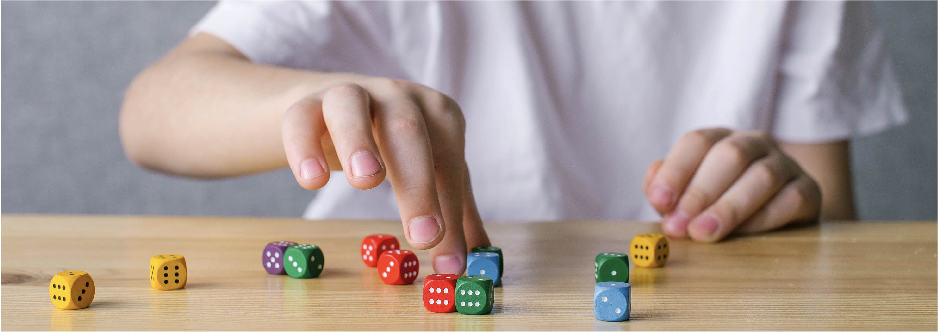
🎯 Did you know games are highly beneficial for elementary learning?
Click and read more about it!
🧮 Want more math games?
Click here for awesome math board games!
Dice games provide a hands-on and interactive experience that engages children and let’s be real, dice just make learning more fun. And when kids are having fun, they’re way more likely to want to play along for long periods of time, even if it is a math game.
🎲 Teacher Tip: Here’s a fun way to boost math skills with dice!
Get elementary kids excited about math while tapping into their love for gaming with our engaging Math Bingo Dice Game Printable.
This dynamic activity combines the thrill of rolling dice with the challenge of solving math equations, providing a fun and effective way to combat the summer brain drain.
💡 And don’t stop with dice, check out this card game for kids:
Elevate Elementary Math Skills with This Exciting Math Card Game
You’ll also want to try this awesome dice game! It’s a student favourite in my upper elementary classroom. 👇 ⏰ 🎲
🎲 Looking for a great set of dice?!?
Our blog 21 Fun Math Games with Dice includes a FREE printable dice template! Kids can color, cut, fold, and start playing in minutes!
Add dice games to your language lessons, too!
Dice games aren’t just for math you know.
They are a fun and engaging way to enhance language skills in children of all ages. By incorporating vocabulary words and language concepts into gameplay, children can practice using language in a meaningful and fun way.
Try some of these simple language dice games!
To avoid the summer brain drain, incorporate these language dice games into your summer schedule to add an element of excitement and interactivity. They provide a playful way to reinforce language skills, vocabulary, grammar, and storytelling, making the learning experience enjoyable and engaging for elementary-aged kids.
🎲 Category Challenge
This game expands vocabulary, category knowledge, and word association skills. Players also practice their addition and subtraction. Yay, math practice!
How to Play:
One die is needed and each of the six numbers on the die will correspond to different predetermined categories, such as animals, colours, books, or food.
Here’s an example of what your list might look like:
The more specific you are about the categories the better!
1. 📐 Things that are triangle shaped
2. 🥦 Green vegetables
3. 👟 Things you wear
4. 🛞 Things with wheels
5. 🍎 Red fruits
6. 🦩 Animals with wings
Players take turns rolling the die to determine the category they will need to generate words for.

After each roll, players will have thirty seconds to brainstorm words related to the category indicated by the die. They can jot down all their ideas but must ultimately choose one word that they deem the most original.
Once the thirty seconds are up, players will compare their chosen words with the rest of the group.
Scoring is as follows:
➡️ Players earn 1 point for presenting a word that is unique and not chosen by any other player.
➡️ If a player cannot think of a word for the category within the given time, they lose 1 point.
➡️ If multiple players present the same word, all players with that same word score zero points for the round.
This scoring system rewards originality, challenges quick thinking, and encourages players to come up with unique words.
💡 Teacher Tip: Put the students to work!
Have students work together to come up with the list of six categories without the help of an adult because, well, that’s so Montessori!
🎲 Roll A Story Dice Game
With this type of activity, children will generate enough ideas and excitement to put together one fascinating fiction story!
How to Play:
Have players use our printable Roll A Story Dice Game (or something similar) to roll their way to writing a creative story.
Story dice are great for reluctant writers, developing imaginative minds, and encouraging students to use their creativity. Plus, it makes for an excellent activity to beat the summer brain drain.
Our build-it-yourself dice game includes 8 printable 2D nets that you can assemble into dice, each featuring a different story element.
The images on each die are engaging, thought-provoking, and open to interpretation, sparking students’ story-writing ideas with just the right amount of guidance.
And the best part is, activities like Roll A Story can be enjoyed repeatedly, ensuring endless fun and writing opportunities!
💡 Teacher Tip: You can use this one product in so many different ways!
Discover endless creative writing possibilities with a variety of activities you can try with our Roll A Story Dice Game.
Read our blog The Best Story Dice and 11 Interesting Ways To Use Them to explore the full potential of this super awesome language activity.
🎲 Parts of Speech Dice Game
Elementary students will explore nouns, verbs, adjectives, and more as they roll their way to language mastery.
💡 We wrote a blog covering the 8 parts of speech!
And don’t miss out on the educational and enjoyable videos featured in our blog Parts of Speech Videos for Your Elementary Language Lessons.
Here’s a quick refresher on the 8 parts of speech and their functions:
🐕 Noun: A person, place, thing, or idea.
🔥 Adjective: Describes a noun or pronoun.
🐾 Pronoun: Used in place of a noun to avoid repetition.
🏃🏽♂️ Verb: Expresses an action, occurrence, or state of being.
💪🏽 Adverb: Describes a verb, adjective, or another adverb.
🔗 Conjunction: Connects words, phrases, or clauses in a sentence.
📥 Preposition: Shows a relationship between two words.
🗯️ Interjection: A word or phrase that expresses strong emotion or sudden feeling.
How to Play:
Choose 6 of the 8 parts of speech to work with and number them from 1 to 6 like the example below. They can be placed in any order.
Players take turns rolling a die and coming up with a word for the part of speech that corresponds to the number they land on.
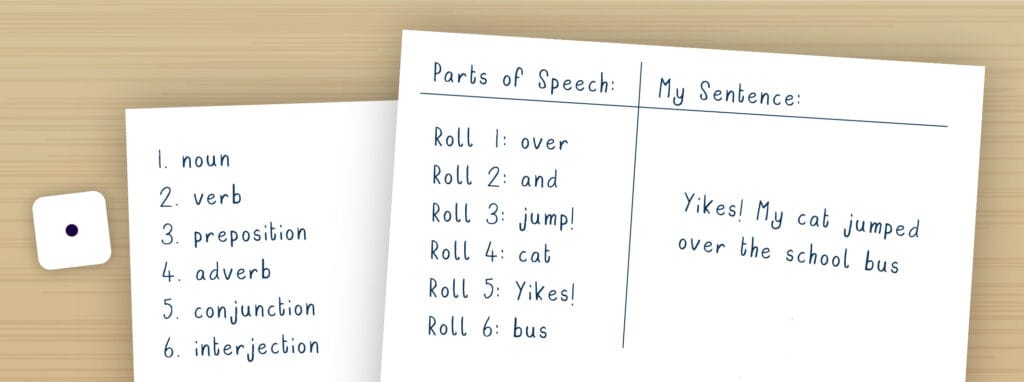
After a set number of rolls or a timed round, players use their words to create a complete sentence. They can freely add any missing parts of speech, like pronouns, adjectives, or articles, to make it work.
I usually stick to 5–6 rolls per player, but with older students, I bump it up to 8–10 for a fun challenge (and great discussions about run-on sentences!).
Wrap up the game by having players share their silly or clever sentences with each other, it’s always a hit and often leads to teachable moments!
💡Teacher Tip: Additional Parts of Speech Practice!
Encourage elementary students to use the engaging Mad Libs app for language skill development.
It offers a creative platform to reinforce and enhance language skills.
🎲 Play any or all of the 15 dice games in our blog:
We’ve put together 15 other educational games using three dice. Here you’ll find engaging activities that will help build a plethora of elementary skills.
The list contains 5 math games, 5 language games, and 5 physical education games, all using three dice. It’s a valuable resource worth reading and saving for future reference.
Here’s another fun and simple story-writing dice game to play with kids:
Who doesn’t love a good group story-building activity with dice? I sure do!
3. Practice Math Skills in Real Life
In my experience as both a teacher and step-mom, math is the subject where kids lose the most ground over the summer.
However, by weaving math into everyday activities and using fun games and resources, you can help your child maintain – and even strengthen – their math skills, avoiding the dreaded summer learning loss.
Here are some engaging ways to put a stop to the summer brain drain by practicing math skills in real life:
🛒 Grocery Store Math
Engage kids in visits to the grocery store by involving them in activities such as couponing, comparing prices, calculating discounts, weighing fruits or vegetables, estimating the total cost of items, or counting money to pay.
This hands-on experience helps children understand the practical application of math in everyday situations.

🧑🏽🍳 Cooking and Baking
Involve elementary-aged children in cooking or baking activities where they can measure ingredients, follow recipes, understand fractions, and even learn about temperature and time.
These fun and meaningful moments not only support math learning but also build confidence and independence in the kitchen.
🪴 Gardening
When you’re working in the garden, have your elementary-aged child join in! They can measure the dimensions of plant beds, estimate the volume of soil needed, and calculate watering or fertilizing amounts. This integrates math with science and allows for hands-on learning.
Teach those budding gardeners all about seeds before they get their hands in the dirt!
♟️ Board Games and Card Games
Play games that involve mathematical operations and problem-solving.
Try some of these games:
🪄 Proof! Math Game – The Fast Paced Game of Mental Math Magic
🎩 Monopoly
🔴 Math Fact Practice Bingo Printable
🔢 Sudoku for Kids
🃏 Multiplication Math War Card Game
🔑 Crypto Math Riddle Digital Game Board
💡Find really fun math board games here:
25 Math Board Games Kids Love and Teachers Approve!
These games improve critical thinking, strategic planning, and mathematical fluency in an enjoyable and interactive way.
📐 DIY Projects and Crafts
Engage in DIY projects where your child can measure and (safely) cut materials, estimate quantities, and follow step-by-step instructions. This hones their spatial awareness, measurement skills, and ability to interpret diagrams or patterns.
Combat the summer brain drain with these engaging and hands-on DIY activities for kids!
🔢 Math Apps and Online Resources to Beat the Summer Brain Drain
Explore educational math apps and online resources that offer interactive games, puzzles, and challenges tailored to different age groups. These platforms provide a gamified approach to learning math and can make practice enjoyable.
Keep reading for more! We expand on this idea further in section #4 of this blog.
🍋 Encourage Kids to Start a Small Business
Get them to learn about money and its value the good old-fashioned way! A lot can be learned from running a lemonade stand, a garage sale, or a small business selling homemade goods.
Encourage your kids to read Kid Start-Up: How YOU Can Become an Entrepreneur. Start a conversation with them about ways they can make money and what that looks like.
You’ll be amazed by the creative ideas your young entrepreneurs will generate!
📏 Measurement in the Real World
Provide opportunities for kids to explore measurement by engaging in real-world activities that involve measuring things.
Whether they’re measuring their height, ingredients for a recipe, timing a race, or comparing shoe sizes, kids always love applying math in the real world. It’s learning through doing, and it sticks!

Here are some more fun ways to learn through measurement:
🏃🏽♂️ Measure the length of their stride or the distance they can jump.
🥤 Pour water into different containers to measure volume using measuring cups.
⚖️ Weigh various foods with a kitchen scale or balance.
🌳 Measure the circumference of objects like tree trunks or their own head.
Plus, don’t forget to use maps to calculate distances between places! And for an extra challenge, delve into telling time by creating a daily schedule or using analog clocks.
It is possible to have a summer of hands-on learning and fun with measurement!
🌍 Learn about Money Through Books
Learning about money through reading money books for kids offers a practical and engaging way to reinforce math skills while also preventing the summer brain drain in elementary students.

By exploring the concepts of earning, saving, and spending money, children develop essential financial literacy skills and apply mathematical concepts in real-life scenarios. These books provide a valuable opportunity for children to understand the value of money, make informed decisions, and develop critical thinking skills.
Here’s a list of money books for elementary kids – our curious second plane learners – to enjoy and learn about money this summer.
💰 The Coin Counting Book by Rozanne Lanczak Williams
💰 Alexander Who Used To Be Rich Last Sunday by Judith Viorst
💰 Finance 101 for Kids: Money Lessons Children Cannot Afford to Miss by Walter Andal
💰 How to Turn $100 into $1,000,000: Earn! Save! Invest! by James McKenna, Jeannine Glista, and Matt Fontaine
💰 The Everything Kids Money Book by Brette Sember
They can improve their math skills and learn about saving by making their own paper bank machines!
4. Sign Your Kids Up for Summer Programs
Enroll your child in summer programs to beat summer brain drain and boost learning.
Look for local summer programs.
There are various summer programs available for elementary students that offer learning in disguise opportunities! These programs cover a wide range of subjects and activities, catering to various interests and age groups.
Some summer programs focus on specific subjects like nature, science, technology, engineering, and mathematics (STEM), where children engage in hands-on experiments, coding projects, and robotics.
Others may offer arts and crafts workshops, theatre productions, or music lessons, fostering creativity and self-expression.
To explore these options, I recommend asking around your community and reaching out to your school board. If they don’t have the information you need, they’ll know where to send you.
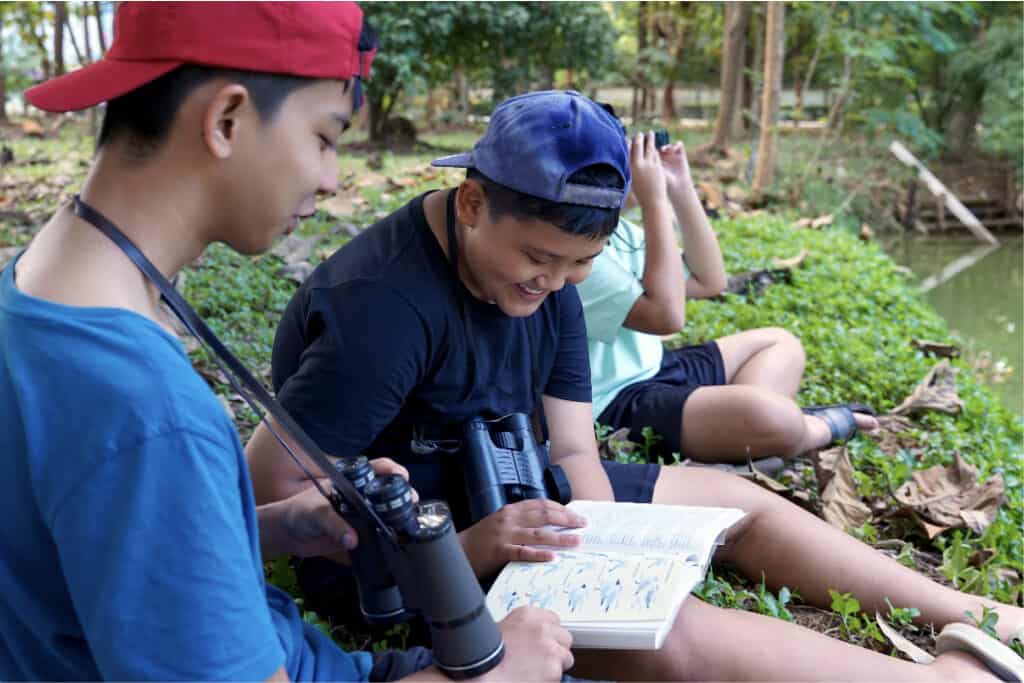
By enrolling your child in a summer program, you provide them with structured learning experiences that foster personal growth, social interactions, and intellectual stimulation outside of their typical learning environment.
They’ll keep skills, find passions, and build confidence for future success.
Enroll them in summer programs to enjoy a season packed with enriching experiences, new friendships, and plenty of chances for growth and learning. It’s the perfect antidote to the summer brain drain!
Discover the world of online summer classes!
When it comes to summer learning, don’t limit yourself to traditional in-person programs. Embrace the exciting realm of online summer courses, where a vast array of captivating subjects and topics await.
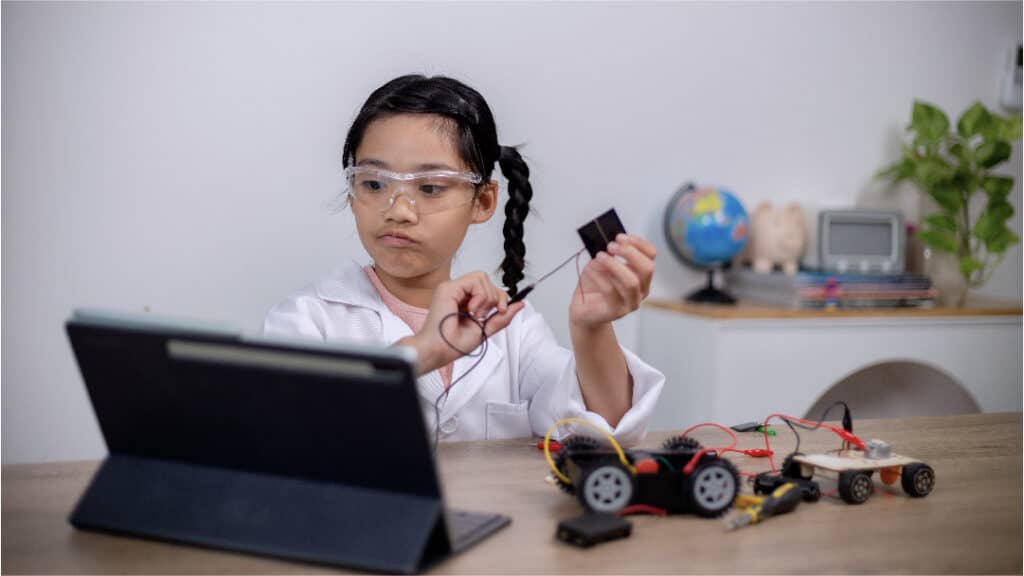
Online summer classes let elementary students learn from home. The virtual format offers flexibility and easy access. Kids can explore subjects at their own pace.
OutSchool is a great example of this and has an expansive list of online classes and teachers to choose from. There are short and long courses, both live and pre-recorded. There’s truly something to meet every student’s needs and interests!
Here are some of our favourite Outschool classes:
🌍 Model UN Summer Camp – United Nations and Politics for Beginners
💬 Introduction to Debate Summer Camp for Elementary Students
🤓 Groovy Greeks Summer Camp – An Adventure Through History
📈 Stock Market – Investing for Beginners Part 1
🛠️ Fun STEM Cooking Summer Camp
🎸 1:1 Summer Music Lessons
💡 Teacher Tip: Turn your teaching skills into profit with Outschool!
Looking for a way to make some extra money using your teaching skills? Why not create your own classes and teach them on OutSchool?
I’ve had only positive experiences teaching students my own unique curriculum on OutSchool. It’s been a great way to make extra money when I have the time to teach.
Get started teaching on OutSchool now! Use this link to get going!
5. Create a Flexible Yet Structured Summer Learning Plan
Another way to prevent summer learning loss is a flexible summer routine.
To combat the summer brain drain, it’s important to create a well-balanced schedule that includes structured learning time while keeping it enjoyable.
The key is to design a routine that aligns with their interests and can be followed consistently. It’s not about strict hours, but a flexible plan that fits learning into daily life. It also gives them some ideas of what they could be doing if they’re bored!
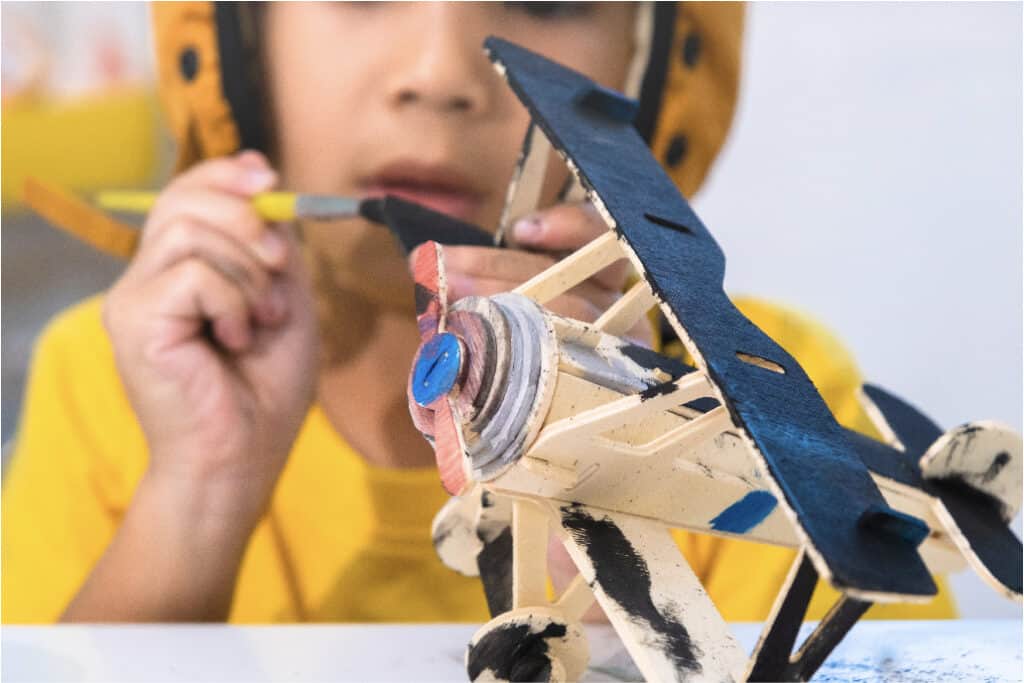
By adding fun activities to the routine, kids can keep learning without stress.
This can include reading books on topics they find fascinating, exploring educational apps or online platforms, engaging in hands-on experiments or projects, or even participating in educational games and puzzles.
The goal is to make learning a natural part of their summer experience, helping them build new skills and knowledge in a fun, low-pressure way.
Transform Your Week with Daily Themes!
Inject excitement into your summer routine by assigning a unique theme to each day of the week. Here’s a lineup of engaging themes that elementary kids love.
Feel free to use these as a model for your kid’s weekly summer schedule:
✂️ Make Something Monday
🕺 Try Something New Tuesday
🌎 Where in the World Wednesday
🧘🏼 Thoughtful Thursday
👟 Fitness Fun Friday
📍Sightseeing Saturday
🎥 Cinema Sundays
GET THIS WEEKLY ACTIVITY PLANNER FREE!
Subscribe to our newsletter and receive this Customizable Daily Activity Planner printable for free.
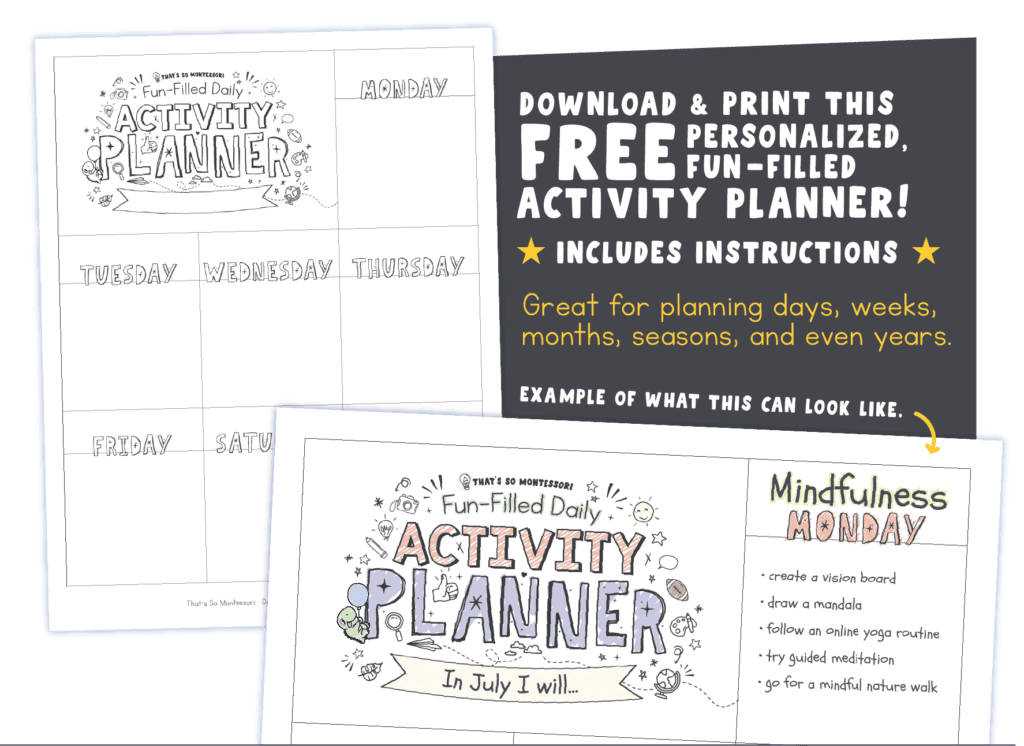
💡 Teacher Tip: Involve your kids in crafting a summer schedule!
Engage your children in creating their own summer learning schedule – it’s a game-changer!
When kids actively participate in crafting their schedules, they feel a sense of ownership and excitement. It’s about tapping into their interests and making learning a blast!
Kids often come up with brilliant ideas we adults may not even think of. Letting them take the lead fosters independence and develops crucial skills like time management and decision-making. Embrace this approach for a rewarding summer of learning!
Make this summer one to remember by incorporating exciting daily themes into your routine. Whether you choose to follow them as outlined or customize them to suit your family’s interests, the possibilities for adventure and learning are endless.
6. Going Out – Take a Purposeful Field Trip
In Montessori education, there’s a concept called ‘going out‘ and it’s similar to the idea of taking field trips, but with one key distinction: the outings are planned by the students themselves.
This unique approach to exploration is filled with teachable moments. Students are empowered to take responsibility for their learning fostering independence, curiosity, and real-world engagement.
Gain a deeper understanding of the Montessori concept of “going out” and its significance in the second plane of development with these insightful videos.
To prevent the summer slide and keep kids learning, help your elementary-aged child plan a day trip. It’s a fun way to explore their interests and learn in the real world.
From science centers and art museums to city parks and historical landmarks, these going out destinations offer unique opportunities for children to explore and learn in a fun and engaging way as they take the initiative to research, plan, and arrange the logistics of their outings.
Chat with your child, follow their interests, and help them plan a fun family field trip. It’s a great way to spark curiosity and grow their love of learning.
Not sure where to go?

Here are some ideas of places in your area that your child may want to visit:
🔬 Science Museum or Science Center
🖼 Art Museum or Art Gallery
🏰 Historical Sites or History Museums
🦉 Wildlife Sanctuary
🚜 Farm or Agricultural Center
🌳 Botanical Garden or Nature Reserve
🪐 Planetarium or Space Observatory
🎭 Children’s Theater or Performing Arts Center
These child-driven outings break up the regular summer routine while offering real-world, hands-on learning that introduces kids to new ideas and experiences.
Keep in mind, going out doesn’t always have to mean visiting museums or theaters. There are plenty of other options for engaging and educational experiences right outside your doorstep!
Consider activities like nature walks and scavenger hunts, which offer unique opportunities for exploration, learning, and fun. The best part? They are cost-effective and can be enjoyed as a family or with friends.
Want more going out ideas?
Here you go:
🪁 Visit Local Parks
🌿 Go on Nature Walks
🧩 Do a Scavenger Hunt
🌱 Explore a Garden
🔭 Observe the Stars
🐚 Collect Items from Nature to Make Art

Remember, while some of these activities won’t cost you a thing, or are not too expensive, they will require your time, involvement, and guidance.
By incorporating educational experiences into your child’s summer break outings, you can create valuable learning opportunities that are both enjoyable and easy on the wallet.
Don’t let the summer months lead to the dreaded summer brain drain! Instead, seize the opportunity to keep your child intellectually stimulated and motivated. By taking advantage of purposeful going out experiences near you or online, you can provide them with a continuous stream of engaging activities and something exciting to look forward to.
💡 Teacher Tip: Take that going out experience up a notch!
Enhance your child’s going out experience by incorporating engaging follow-up activities that deepen their connection and understanding.
Try these going out follow-up activities with your kids:
🗺 Travel Brochure
Look at travel brochures while you are out (if you come across any) and have elementary-aged children create their own colourful and informative travel brochures focusing on the place they visited.
They can include details about the attractions, historical facts, and interesting highlights. This project allows them to practice their research, writing, and design skills while sharing their experience with others.
📒 Going Out Journal
A going out journal is where kids can document their thoughts, observations, and sketches during the trip. They can write about their favourite moments, interesting things they learned, or any questions that arose.
This project promotes reflection, improves writing skills, and allows them to preserve their memories in a personal and creative way.
🎨 Artistic Expression
Suggest children express their experiences through art. They can create paintings, print photos, make collages, or even sculptures inspired by their outing, capturing the essence of what they saw, felt, and learned.
This activity provides a powerful medium for them to translate their observations, emotions, and newfound knowledge into tangible and visual representations.

🗣 Presentation Time
Encourage kids to prepare a short presentation to share with the family or even their friends about their going out experience. They can use visual aids such as photographs, drawings, poster boards, or objects they collected during the trip.
This project helps improve their public speaking skills, boosts confidence, and allows them to become an expert on the topic, sharing their knowledge with others.
Remember, provide guidance and support but keep your hands to yourself throughout these mini projects, allowing the child to express their creativity and reflect on their field trip experience in their own meaningful way.
7. Encourage Physical Activity to Beat the Summer Brain Drain
To combat the summer slide, it’s essential to encourage physical activity alongside intellectual stimulation.
Embracing outdoor adventures like swimming, biking, or hiking not only fosters physical fitness but also supercharges cognitive function.
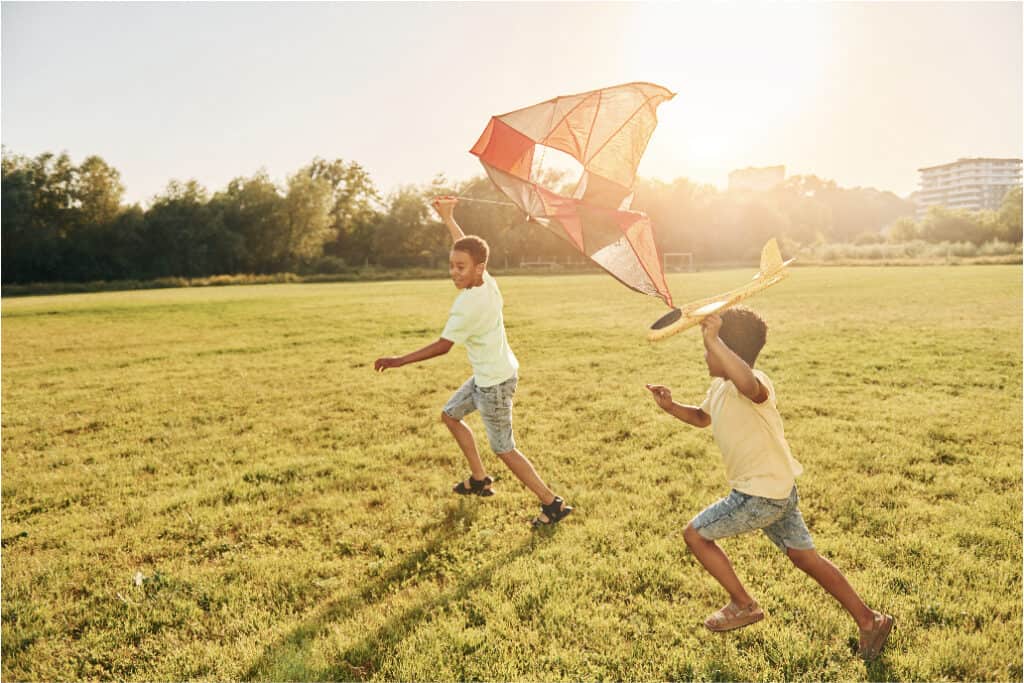
Exploring nature through activities like bird-watching or nature walks fosters curiosity, observation skills, and a deeper appreciation for the environment while also building muscular endurance. Adventure activities like rock climbing or obstacle courses promote problem-solving, resilience, and self-confidence while also building muscles!
But that’s not all. Physical activity goes beyond fitness, it profoundly impacts the brain. Regular exercise increases blood flow, enhancing focus, attention, and memory. And let’s not forget about those wonderful endorphins, the mood-boosting chemicals that reduce stress and elevate overall well-being.
So it’s time you weave physical activity into your child’s summer schedule and witness their minds and bodies thrive, as they build healthy habits that will not only build resilience and strength but also ignite a passion for exercising regularly.
Check out these great fitness videos for kids to follow along with:
Why not combine physical activity and learning with activities like these:
✅ Scavenger Hunts
✅ Historical or Guided Walking Tours
✅ Just Roll With It
✅ Plant Identification on a Hike
✅ Move Like an Animal Exercises
✅ Geocaching Adventures
Elevate summer excitement while defeating the summer brain drain by integrating physical activity into their summer routine. Children will soak up knowledge, improve their fitness levels, and forge lasting memories through dynamic and immersive movement activities.
💡 Teacher Tip: Engage, Adapt, and Join in the Fun!
When it comes to physical activity, it’s important to adapt movements to your child’s age, abilities, and interests. Every child is unique, and by tailoring the activities to their individual needs, you can create a more meaningful and enjoyable experience.
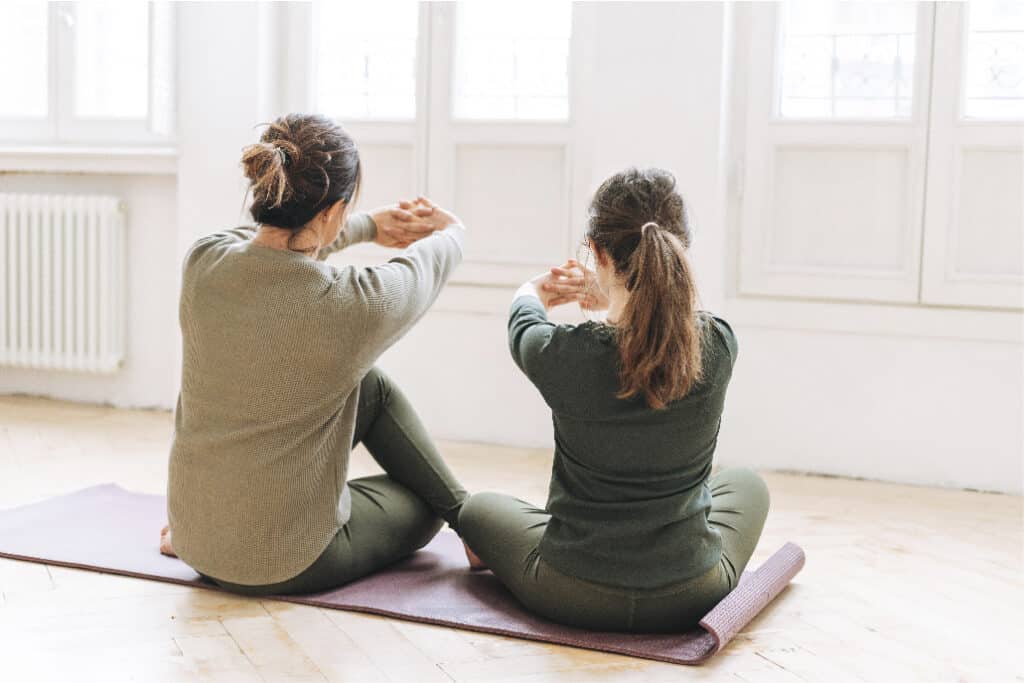
And be sure to join in on the fun!
By modeling movement and actively participating, you not only foster your child’s curiosity, physicality, and love for movement but also create a stronger bond and shared learning experience.
8. Digital Learning for Combatting Summer Brain Drain
We get it. Summer is all about unwinding and taking it easy. But guess what? It’s also the perfect time for making learning fun!
Thanks to the vast array of digital products, children are able to turn their summer break into a brain-boosting adventure. Many interactive apps are entertaining and purposeful, ensuring that kids can keep their minds sharp.
From captivating games to activities that are engaging and reinforce existing knowledge, it’s fair to say that when used in moderation educational apps offer a different way for children to connect with their education.
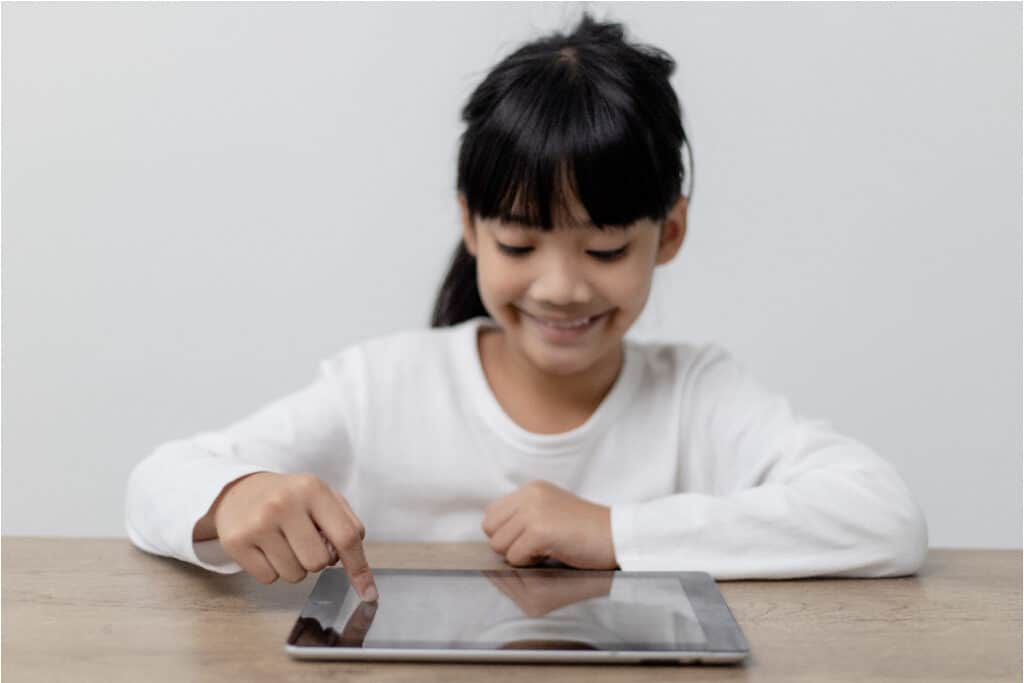
Here are a few educational apps that we love for the elementary level:
✅ Reflex Math
✅ Math Bingo
✅ Khan Academy Kids
✅ Duolingo
✅ ABCmouse
✅ Homer
✅ Prodigy
Night Zookeeper is a great example of an online learning program that boosts kids learning. This game seamlessly disguises learning as it inspires and empowers students to unleash their imagination through storytelling and thrilling adventures.
Check out this tutorial video:
There’s also Hopscotch Coding. This app, designed specifically for young learners, provides an interactive and playful platform that introduces children to the fascinating world of coding and computer programming.
Here’s a video sample of a Hopscotch Coding lesson:
⚠️ Remember to review and assess the content and features of each app to ensure they align with your child’s educational needs and are suitable for their age group and abilities.**
Digital Resources Beyond Apps for Elementary-Aged Children
The options go beyond apps when it comes to digital resources.
Discover a world of possibilities with products like our engaging and ready-to-teach Google Slide lessons and activities that make learning fun for elementary learners:
🔬 Periodic table of elements Lesson
🔢 Digital Math Games Lesson with Worksheets
😂 Math Jokes for Kids
🔑 Crypto Riddles Math Fact Practice
🟩 Digital Montessori Checkerboard Lessons
♟️ Digital Montessori Racks and Tubes Bundle
😺 Carl the Cantankerous Cat Digital Picture Book + Printable Activity Pack
🐸 Word of the Week Vocabulary Boosters + Printable Graphic Organizer
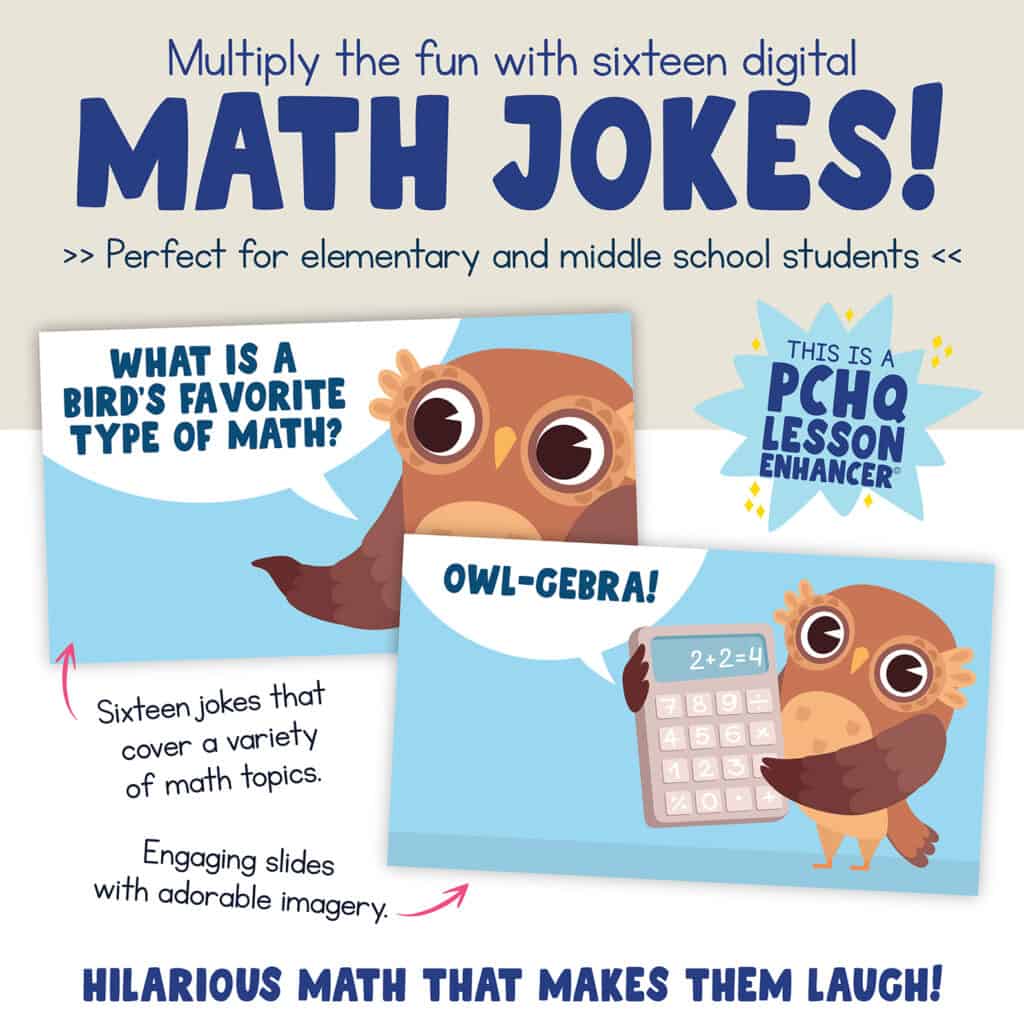

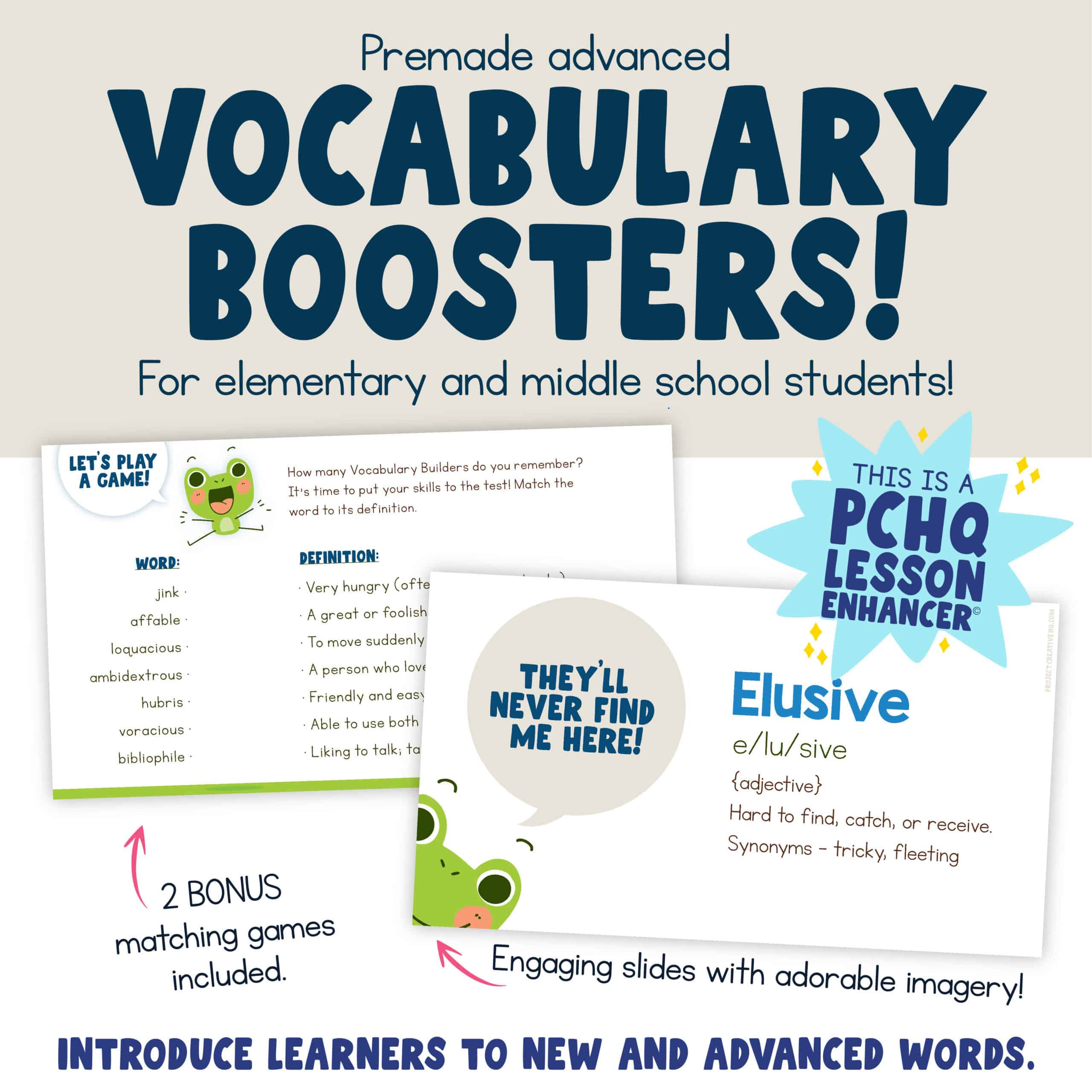
All of our products are designed to enhance elementary learning and captivate young, inquisitive minds.
See for yourself! Check out our FREE Language and Math Product Sample Pack.
📺 Get them learning with YouTube!
Beat the summer brain drain with engaging activities, and explore our handpicked list of 27 YouTube channels to prevent summer learning loss.
Your kids will thank you!
It’s possible to avoid the summer brain drain and keep your child’s mind active with fun and challenging digital learning tools. Just remember to balance screen time with offline experiences for a well-rounded and enriching summer routine.
9. Use Games to Enhance Their Vocabulary
Using activities and games as vocabulary development activities during the summer break is an effective and enjoyable approach to enhancing their language skills and shaking that summer brain drain.
Language games provide a dynamic and interactive environment where kids can engage with words and expand their vocabulary effortlessly. Once again, there’s that learning in disguise!
Rebus puzzles are a fantastic brain game to include. These clever picture-word combinations help kids think critically, build language skills, and stay mentally active in a fun, low-pressure way. They’re perfect for keeping young minds sharp while adding a little mystery and creativity to summer learning.
Here are some fun games and activities where elementary-aged kids can practice their vocabulary skills:
🃏 Board Games like Upwords, Scattergories, Tapple, and Balderdash
😺 Noun Memory Matching Game
📘 Books with Rich Vocabulary
💬 Word of the Day Challenge
🎨 Pictionary
✏️ Vocabulary Scavenger Hunt
🧩 Crossword Puzzles
🎲 Story Dice
🎯 Rebus Puzzles
💡 Teacher Tip: Challenge kids to learn a new word each week!
Make this summer a memorable linguistic adventure by having your child (and maybe the entire family) commit to learning a new word every week.
Encourage everyone to actively attempt to use the word of the week in their conversations, stories, and daily activities. This repetition will not only deepen the understanding of each word but also seamlessly integrate them into your everyday language.
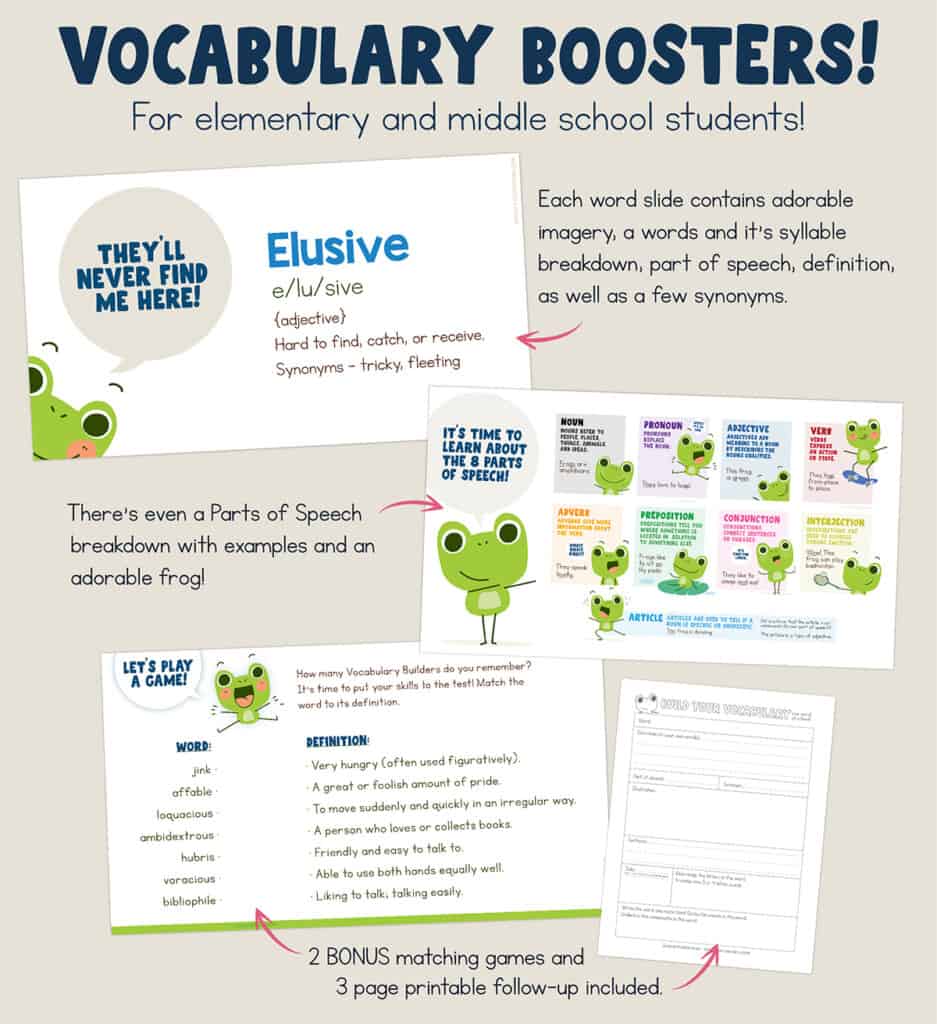
By transforming vocabulary building into a playful, family experience, you can foster their love for language and empower them with a rich and diverse vocabulary while they’re on summer break.
It Is Possible to Stop the Summer Brain Drain!
With a little planning, resources like this blog, and some creativity, it’s entirely possible to prevent that drastic loss of knowledge and keep your child’s brain engaged during the summer months.

💡Teacher Tip: Pin this post!
Don’t let this valuable blog slip away! Create a dedicated list or folder where you can save insightful blogs, like this one, filled with helpful information and creative ideas.
Unlock the Benefits of Keeping Kids Engaged This Summer
There are so many benefits to keeping kids busy learning over the summer break.
Here are just a few:
✅ prevent summer learning loss;
✅ help children retain information and skills they learned during the school year;
✅ set them up for success in the upcoming school year;
✅ enhance critical thinking, problem-solving, and creativity;
✅ boost confidence and self-esteem;
✅ expand cultural awareness;
✅ connect learning to real-life experiences;
✅ promote independence;
✅ support smooth transitions to new educational environments;
✅ provide opportunities for children to explore their interests and passions;
✅ foster a love of learning and curiosity that can last a lifetime.

The Wrap-Up: Avoid the Summer Brain Drain
Summer brain drain is a real concern for parents and educators, but it’s not inevitable.
By following the tips outlined in this blog and encouraging the elementary-aged kids in your life to stay engaged in learning over the summer by making learning fun, you will help them avoid the summer brain drain and keep their academic skills sharp.
Learning should feel fun, especially in the summer! With just a bit of planning, your child can stay sharp and head into the new school year feeling confident and ready.
GET THIS FREE PRINTABLE POSITIVE AFFIRMATIONS POSTER!
Join our monthly Newsletter and get this inspiring printable delivered straight to your inbox!
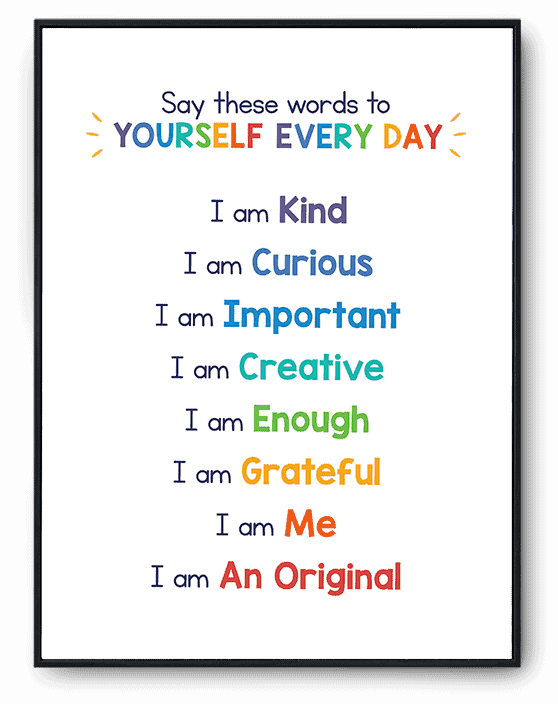
Explore our Collection of Fun Educational Games and Informative Blog Posts
We’re here to help you make learning awesome! From hands-on games to helpful blog posts, our resources are built to spark curiosity and support elementary-aged kids, and the grown-ups who guide them.
🧮 Math
🔢 No Prep Math Fact Dice Game Addition and Division Practice
🤣 Math Jokes for Kids and Teachers
🤓 No-Prep Digital Math Games Lesson with Worksheets
🧩 Crypto-Riddles Math Fact Practice
🔢 Montessori Command Cards: 4 Operations BUNDLE
❎ 120 Distributive Law of Multiplication Command Cards + Answers & Anchor Chart
⚓️ 140 Printable Order of Operations Task Cards With Answers & Anchor Chart
👀 Outdoor Scavenger Hunt Printable Card Game
📚 Language
😼 Carl the Cantankerous Cat
📚 Story Elements Dice Game with Graphic Organizer
💬 Parts of Speech Scavenger Hunt
🔡 Alphabet Scavenger Hunt Printable
🚀 Vocabulary Booster + Printable Graphic Organizer Vol 2
🚀 Vocabulary Booster + Printable Graphic Organizer Vol 1
🐷 Noun Memory Animal Matching Game
😺 Carl the Cantankerous Cat Digital Picture Book + Printable Activity Pack
🏠 Indoor Scavenger Hunt
👀 Outdoor Scavenger Hunt
🤩 Miscellaneous Fun and Learning
🧪 Periodic Table of Elements Lessons
🎲 Movement Dice – Just Roll With It
😻 Cat-Themed Printable Tic Tac Toe
😸 Cat Emoji Set
😁 Emojis Faces Set
🤖 Build a Robot Pack #1
🦾 Build a Robot Pack #2

📰 Have You Read These Blogs Yet?
🎯 15 Benefits of Using Games in the Classroom
🔎 Scavenger Hunt Meets ABCs – A Printable Kids Will Love
👀 How to Make a Scavenger Hunt for Kids in 9 Steps
🏃🏽♂️The Best Neighborhood Walk Scavenger Hunt & 13 Different Ways to Use It
🧩 8 Easy Rebus Puzzles with Answers
📝 11 Ways to Use Our Roll A Story Dice Game
🎲 15 Educational Games With Three Dice for Kids (+ FREE Printable Dice)
💡 Your Kids Need This Activity Book with Unique Drawing Prompts
🔢 21 Fun Math Games with Dice to Try With Kids 8-12 (+ FREE Printable Dice)
💬 The Ultimate 13 Vocabulary Development Activities for Kids
🧮 9 Montessori-Aligned Math Activities for Elementary Students




